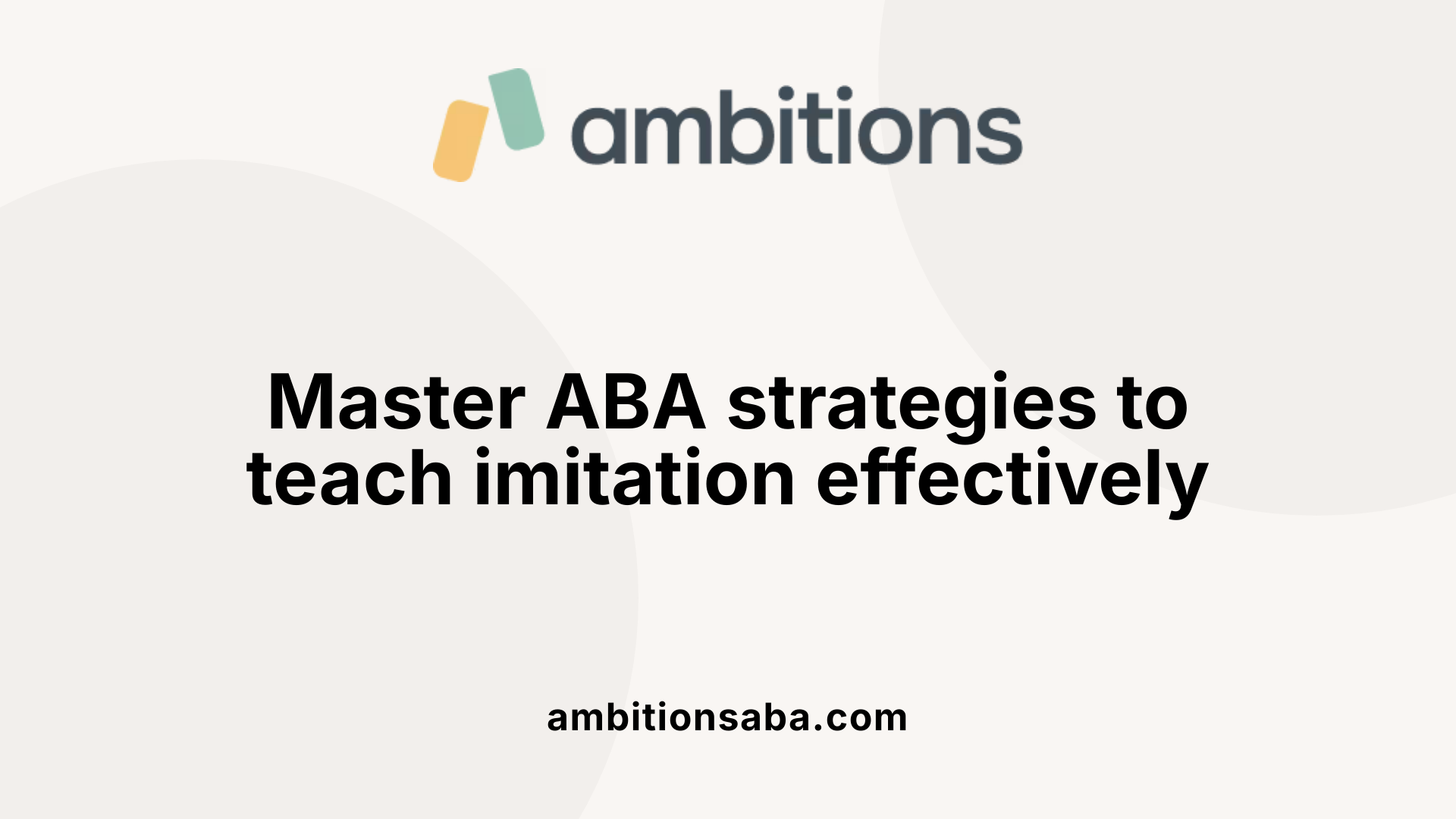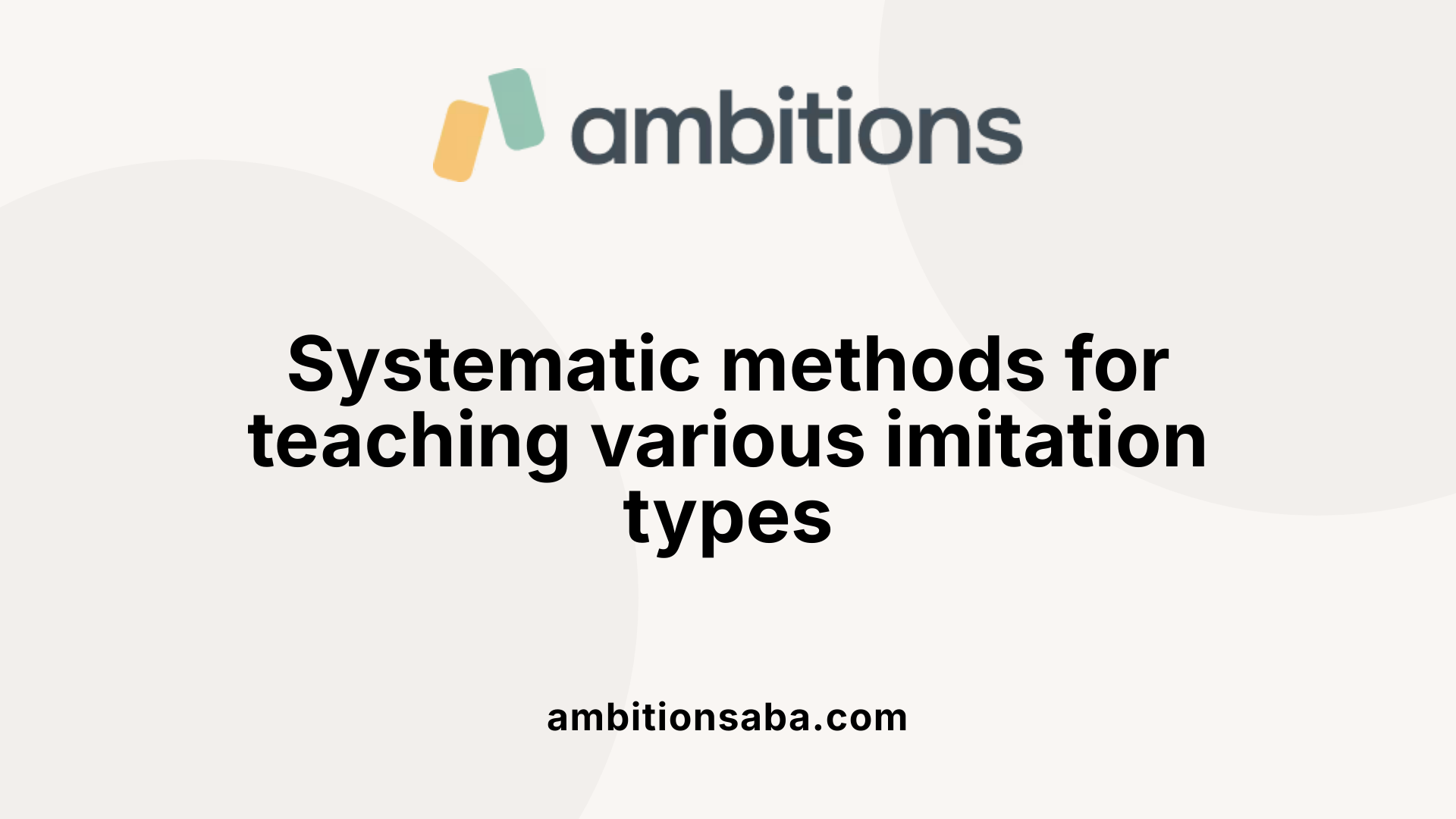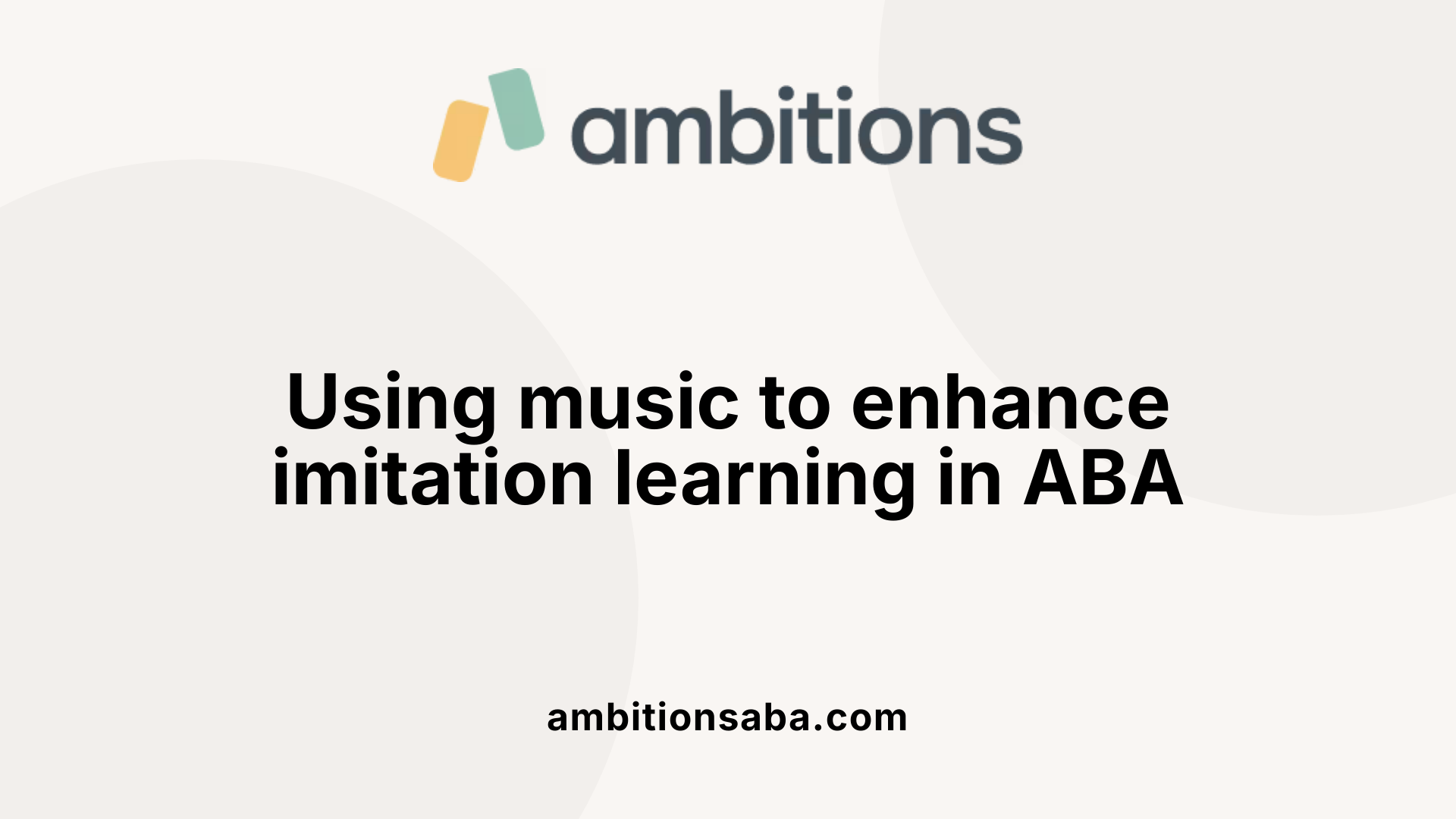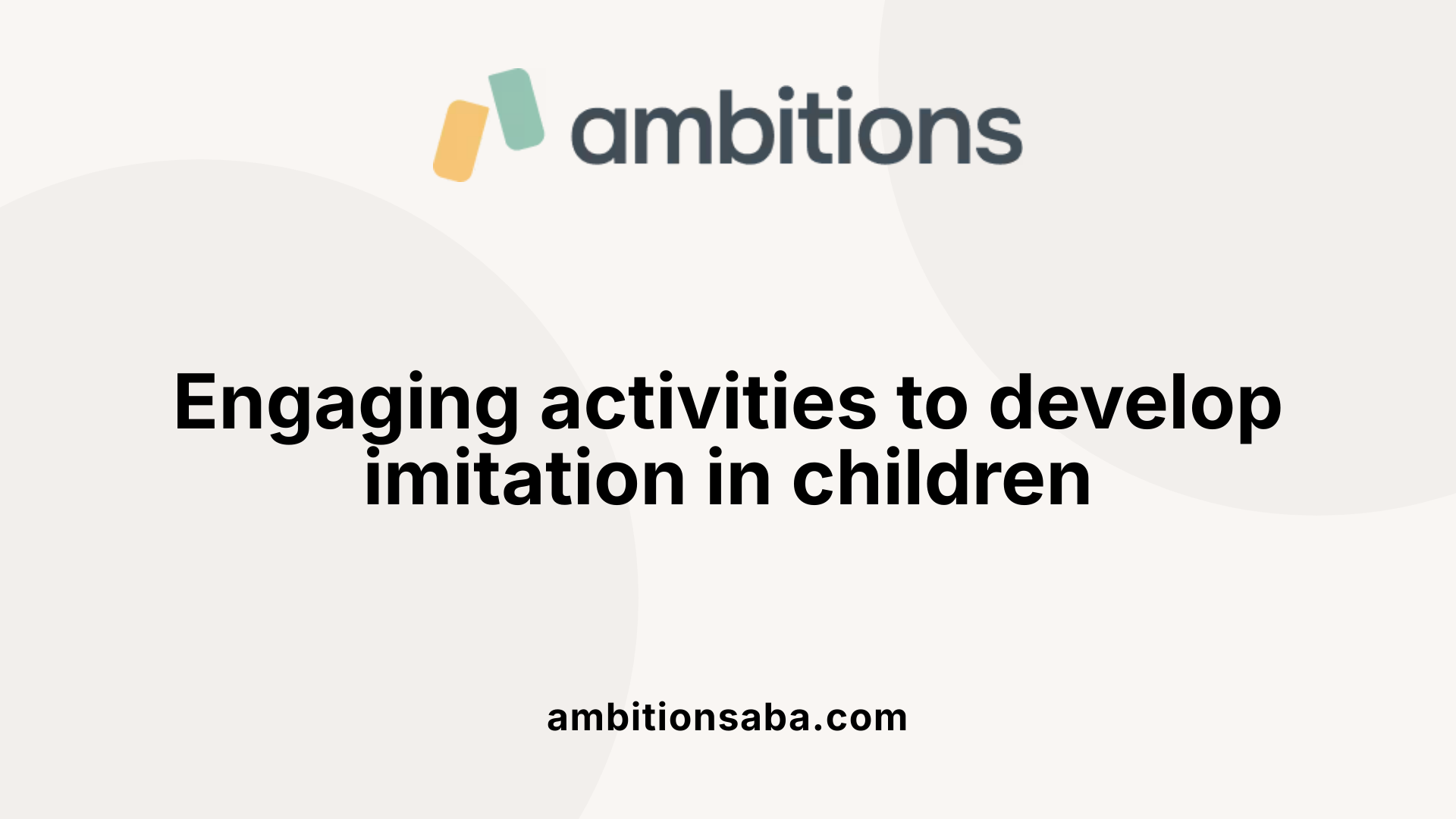The Vital Role of Imitation in Child Development and Autism Intervention
Imitation is a fundamental skill that underpins a child's ability to learn, socialize, and develop essential skills. For children with autism spectrum disorder (ASD), delays or deficits in imitation can significantly impact their learning trajectory and social integration. Utilizing Applied Behavior Analysis (ABA) techniques provides structured, evidence-based strategies to teach and reinforce imitation skills, thereby fostering broader developmental gains. This article explores how ABA facilitates imitation learning, the importance of tailored approaches, and innovative methods such as music therapy and social robots that enhance engagement and generalization.
The Significance of Imitation in Child Development and ABA Therapy
Why are imitation skills important in child development and ABA therapy?
Imitation is a fundamental process in early childhood that significantly influences learning and social interactions. It involves copying behaviors, gestures, words, or expressions that are modeled by others, and serves as an essential tool for acquiring new skills and understanding social cues.
In child development, imitation facilitates learning in multiple domains. Children learn to produce speech, develop motor skills, and engage in social exchanges by observing and mimicking those around them. For example, a child might learn to wave hello or say thank you after watching someone do it. This process is critical for building communication skills, understanding emotions, and participating in play.
Applied Behavior Analysis (ABA) therapy emphasizes teaching imitation skills because they are foundational for broader developmental progress. ABA-based interventions often start with modeling behaviors, prompting imitation, then reinforcing successful attempts, and finally fading prompts to promote independence. This structured approach helps children with autism spectrum disorder (ASD) acquire and generalize imitation skills.
Children with ASD frequently experience delays and challenges in imitation, which can hinder their ability to learn from their environment and engage socially. Without the development of imitation skills, children may struggle with language acquisition, social interaction, and even daily living skills.
By establishing strong imitation abilities, children with ASD can improve their capacity to learn new behaviors more quickly and naturally. Imitation not only supports language development—such as echoing words or phrases—but also enhances social skills like turn-taking and joint attention.
Overall, fostering imitation skills in children, especially those with developmental delays or ASD, acts as a crucial cornerstone for effective intervention. It helps lay the groundwork for acquiring a variety of skills, promoting independence, and enriching social participation.
How does imitation serve as a foundation for learning and social interaction?
Imitation functions as a bridge that connects observation with action. When children imitate, they internalize behaviors and use them as models for further learning. As they practice copying, their brain forms neural connections that underpin language, motor, and social skills.
In social contexts, imitation encourages turn-taking and shared attention, which are critical for meaningful interactions. For example, mimicking a smile or a wave can initiate social exchanges and foster relationships.
Throughout childhood, imitation supports learning across many areas. It aids in understanding facial expressions and body language, which are vital for emotional recognition. It also helps children learn vocabulary and sentence structures by repeating words heard in their environment.
Research demonstrates that children who develop robust imitation skills tend to acquire language faster and show more advanced social skills. Conversely, children with difficulty imitating may experience frustration and social withdrawal.
In summary, imitation is more than just copying; it is a powerful learning and social tool. It underpins the development of language, social competencies, motor abilities, and cognitive skills, making it an essential focus in early intervention strategies such as ABA therapy.
ABA Techniques for Teaching Imitation in Children with Autism

How can ABA techniques be used to teach imitation skills in children, especially those with autism?
Applied Behavior Analysis (ABA) provides a structured and proven approach to teaching imitation skills in children with autism. Central to ABA are strategies such as modeling, prompting, reinforcement, and prompt fading, which work together to facilitate both accurate responses and spontaneous imitation.
Initially, practitioners focus on simple, observable behaviors like object imitation—teaching children to copy actions such as placing a block in a cup. They use identical objects, like spoon or cup, and structure activities to reinforce imitation. For example, they might prompt a child to imitate a basic action, then reinforce their response immediately with praise or a preferred item.
As children become more comfortable, teaching progresses to more complex movements such as gross motor actions—waving or clapping—and eventually to facial and fine motor movements. Throughout this process, prompts are systematically faded. This means starting with strong guidance, like physical prompts, and gradually reducing assistance so children learn to imitate independently.
Naturalistic and play-based methods such as Reciprocal Imitation Training (RIT) are also incorporated. RIT emphasizes spontaneous imitation and turn-taking, which helps motivate children and promote generalization across settings. The use of engaging toys, pretend play, and social robots like QTrobot can boost motivation and reduce anxiety, making imitation practice more enjoyable.
Reinforcement plays a crucial role; immediate positive feedback encourages children to repeat behaviors. Over time, as children demonstrate consistent imitation, prompts are lessened, fostering greater independence.
Moreover, varied models and actions help children expand their imitation repertoire. Moving from simple object imitation to more complex behaviors, including vocal and emotional expressions, supports broader social and communication skills.
In summary, ABA techniques for teaching imitation involve a combination of modeling, prompting, reinforcement, and strategic fading. This systematic approach not only improves children’s imitation responses but also builds a foundation for language, social interactions, and everyday skills, ultimately shaping their overall development.
Strategies to Promote Imitation Using ABA Principles

What are effective strategies for teaching imitation skills using ABA principles?
Teaching imitation skills to children with autism spectrum disorder (ASD) involves structured, systematic approaches based on applied behavior analysis (ABA). One effective method begins with providing clear and consistent modeling of behaviors, where the educator or therapist demonstrates the desired action or response.
Prompting, such as verbal cues, physical guidance, or visual aids, is used to help the child imitate the behavior. Over time, prompts are gradually faded to encourage independent imitation. This process ensures that the child doesn’t become reliant on prompts but instead learns to imitate spontaneously.
Integrating intervention strategies like Discrete Trial Teaching (DTT) with contingent imitation can amplify outcomes. DTT involves structured teaching sessions where specific behaviors are targeted and reinforced, whereas contingent imitation entails modeling children’s motor movements and vocalizations in a naturalistic manner. Combining these strategies often results in increased imitation responses, especially in children who already show some engagement with objects or actions.
Beginning with targeting gross motor and object imitation using identical or similar items (such as spoons, cups, or blocks) helps children learn to replicate actions and facilitates generalization of skills across different settings.
Progression to more complex imitation types—like fine motor movements, oral motor actions, and pretend play—are implemented once foundational skills are mastered. Activities should be engaging and enjoyable to sustain motivation, which helps prevent frustration and supports consistent practice.
Incorporating a variety of prompts, reinforcement, and engaging activities such as imitation games, singing songs ('Head, Shoulders, Knees, and Toes'), or joint attention activities can significantly strengthen imitation skills. For example, turning imitation into a fun game might involve mimicking actions in a playful manner or using social robots like QTrobot, which provide predictable and less anxiety-provoking opportunities for children to imitate.
Using prompts effectively is crucial. For instance, physically guiding the child initially, then gradually fading assistance, helps foster independence. Reinforcement—immediate praise or preferred items—encourages the child to repeat the behavior.
Activities that incorporate imitation into daily routines, pretend play, or social interactions enhance both social and language development. The goal is to create a fun, stimulating environment where imitation naturally occurs, supporting broader developmental domains.
Structured initial modeling, prompt fading, engaging activities
Delivering clear initial models sets a foundation for imitation work. Prompt fading ensures that children are encouraged to perform behaviors independently. Engaging activities foster motivation and consistency, making learning enjoyable.
By systematically applying these ABA strategies—initial modeling, prompt fading, and fun, engaging activities—therapists and parents can effectively teach imitation skills. These strategies support language development, social interactions, and broader skill acquisition, setting the stage for ongoing growth and learning.
Teaching Different Types of Imitation with ABA

How can ABA be applied to teach different types of imitation, such as object imitation?
Applied Behavior Analysis (ABA) offers a structured approach for teaching various kinds of imitation skills, including object imitation, gross motor movements, facial expressions, and oral actions. The process begins with conducting baseline assessments to identify the child's current abilities and preferences. This helps determine which stimuli or actions to target initially.
For object imitation, teachers typically select preferred and functional objects like cups, spoons, or toy sets. The teaching involves modeling the desired action — for example, placing a block in a cup — followed by prompting the child to imitate this action. Prompts can include physical guidance, verbal cues, or visual aids. Reinforcement, such as praise or access to a preferred toy, is provided immediately after correct responses to increase motivation.
Gradual prompt fading is essential. As the child becomes more consistent, prompts are systematically reduced to promote independent imitation. This ensures that responses are not solely stimulus-dependent but are generalized and spontaneous.
The same principles apply across other imitation types. For gross motor imitation, activities like clapping, waving, or jumping are modeled, prompted, and reinforced. Facial imitation may involve mirroring expressions or movements, often using mirrors or video modeling to increase engagement. Oral imitation, such as blowing bubbles or mimicking sounds, is taught with gradual prompts and reinforcement.
Research indicates that establishing imitation at the initial response topography and then expanding to other similar behaviors facilitates generalization. For example, beginning with object imitation can serve as a foundation for teaching more complex play or language skills.
To promote generalization across settings and stimuli, varied exemplars and response types are incorporated. For instance, after mastering object imitation with one set of objects, children can practice with different sets or in different environments, such as in the classroom or during play at home.
In summary, systematic ABA strategies—modeling, prompting, reinforcement, prompt fading, and varied practice—are effective in teaching multiple imitation types. These skills are foundational for language development, social interaction, and learning new skills, and their successful acquisition supports broader developmental progress.
Integrating Music into ABA for Imitation Learning

How can specific approaches like music be incorporated into ABA to facilitate imitation learning?
Incorporating music into ABA strategies offers an engaging and motivating way to enhance imitation skills among children with autism spectrum disorder (ASD). Music serves not only as a fun activity but also as a powerful tool to promote joint attention, language, and motor imitation.
Action songs such as "Head, Shoulders, Knees, and Toes" and "If You’re Happy and You Know It" are commonly used to encourage children to imitate movements, facial expressions, and vocalizations. These songs are structured with repetitive and predictable patterns that facilitate imitation. The exaggerated gestures and tones make imitation easier for children, especially when learning new behaviors.
Musical cues can be embedded into ABA techniques like modeling and prompting. For example, teachers or therapists may sing a movement or phrase and prompt the child to imitate, then reinforce that imitation through praise or additional musical responses. Repeated singing, pauses, or call-and-response segments serve as natural cues for the child to replicate the action or sound.
Research supports the effectiveness of music therapy integrated within ABA. Studies by Lim HA and Draper E demonstrate that combining music with behavioral strategies enhances vocal imitation, expressive language, and motor responses. Such approaches leverage music's inherent motivating properties, making the learning process enjoyable and engaging.
Songs with call-and-response features create an interactive environment where children are encouraged to imitate both words and actions. For instance, a therapist might sing a line and then wait for the child to echo or perform an action, fostering spontaneous imitation.
Overall, using musical cues in ABA not only boosts motivation but also helps children develop imitation skills more effectively. This combination supports learning a wide range of behaviors—from simple motor actions to complex language and social exchanges—making therapy sessions lively and productive.
By blending musical activities with established ABA principles, practitioners can create a dynamic and supportive environment. This approach encourages children to actively participate in their own learning, leading to more consistent progress in imitation and related skills.
| Approach Type | Example Techniques | Benefits | Supporting Research |
|---|---|---|---|
| Musical Engagement | Using songs like "Head, Shoulders" | Enhances motivation and imitation | Lim & Draper (Year) |
| Call-and-Response Songs | Singing with pauses for children to reply | Promotes language and social skills | Peer-reviewed journals |
| Musical Cues | Using melodies to signal behaviors | Reinforces motor and vocal imitation | Systematic reviews |
| Repetitive Actions | Repeating behaviors with musical accompaniment | Improves retention and generalization | Music therapy studies |
Utilizing music in ABA strategies infuses therapy sessions with rhythm, predictability, and joy. This integration supports not only the development of imitation skills but also promotes broader social and communicative competencies.
Activities to Enhance Imitation Skills in Children

What are some activities that can improve imitation skills in children?
Developing imitation skills is fundamental for children’s social, language, and play development. Engaging activities that promote imitation should be fun, natural, and tailored to the child's interests.
One of the most effective ways to build imitation is through imitation games. Classic games like "Simon Says" and "Head, Shoulders, Knees, and Toes" are excellent for encouraging children to copy actions, gestures, and body parts. These games not only teach imitation but also help with listening skills and following directions.
Facial expressions are crucial for emotional understanding. Playing with mirrors and making silly faces or exaggerated expressions can motivate children to mimic facial movements. This activity enhances their ability to recognize and produce facial expressions, which is essential for social interaction.
Incorporating daily routines into imitation activities can be highly beneficial. For example, during dressing, feeding, or toothbrushing, adults can model each step, prompting children to imitate these essential self-care actions. Repeating these routines allows children to observe, learn, and imitate behaviors in real-life contexts.
Arts and crafts also provide great opportunities for imitation. Activities like finger-painting, gluing, or stamping require children to imitate step-by-step instructions or movements. These activities strengthen fine motor imitation and cognitive sequencing.
Singing nursery rhymes and finger plays further develop verbal and gesture imitation. Songs with actions—such as "Itsy Bitsy Spider" or "Pat-a-Catter"—encourage children to imitate both words and movements, fostering language development.
Playing with toys like dolls, blocks, or balls can be used to reinforce imitation. For example, modeling actions like stacking blocks or pretend feeding a doll invites children to imitate those specific actions. When combined with positive reinforcement, these playful activities promote sustained imitation practice and social engagement.
Employing tools like visual supports, including pictures and videos, can also stimulate imitation. Demonstrating desired behaviors through modeling, followed by prompting and reinforcement, creates a comprehensive approach to developing imitation skills.
Overall, incorporating these fun and purposeful activities into daily routines helps children with and without disabilities strengthen their imitation abilities, which serve as a foundation for broader social, language, and cognitive skills.
The Broader Impact of Teaching Imitation Skills Through ABA
Enhancing imitation skills through ABA techniques not only supports immediate skill development but also contributes to long-term social, emotional, and academic success. As imitation forms the basis for language acquisition, social interaction, and daily living skills, systematic teaching approaches that integrate modeling, prompting, reinforcement, and creative tools like music and social robots can significantly improve outcomes for children with ASD. Early and individualized intervention, coupled with engaging activities and naturalistic strategies, paves the way for children to become more independent, socially connected, and competent learners. The integration of innovative methods into ABA emphasizes the importance of a fun, motivating, and comprehensive approach to fostering essential developmental skills.
References
- Teaching Imitation to Young Children with Autism Spectrum ...
- What is Imitation and Why is it Important? - May Institute
- Teaching Imitation to Help Build New Skills [Video] - Relias
- Teaching Object Imitation to Children with Autism - Dr. Mary Barbera
- Teaching Imitation Skills to Young Autistic Students
- How to teach imitation to children with Autism - LuxAI
- How to utilize music in ABA to teach verbal operants? - ResearchGate
- What is Generalized Imitation in ABA - BehaviorPREP
- Generalized imitation and response-class formation in children with ...
- [PDF] Generalized Motor Imitation (GMI) Protocol - TUT ABA Best Practices



